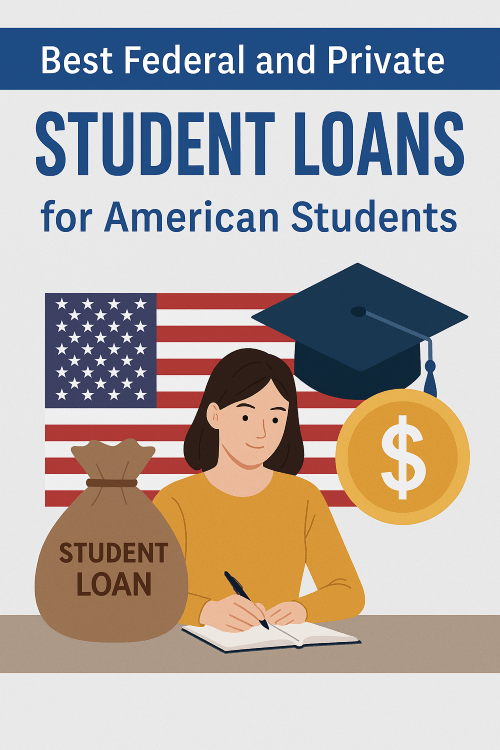Last Updated on May 27, 2025 8:15:11 PM by Vivek Makwana
Explore the best federal and private student loans for American students in 2025. Compare interest rates, benefits, and top lenders to find the right student loan for your college journey.
Paying for college in the United States can be expensive, but student loans can make higher education more accessible. Whether you’re heading to a four-year university or a technical college, knowing the best federal and private student loan options available can help you finance your education wisely.
In this guide, we’ll explore top federal and private student loans for American students in 2025 and what makes each one worth considering.
📘 What Are Student Loans?
Student loans are borrowed funds used to cover college expenses such as tuition, books, housing, and more. There are two main types:
- Federal Student Loans – Offered by the U.S. Department of Education.
- Private Student Loans – Offered by banks, credit unions, or online lenders.
Federal loans are usually the first and best option due to their lower interest rates and flexible repayment plans.
🎓 Best Federal Student Loans for American Students
1. Direct Subsidized Loans
- Best for: Undergraduate students with financial need.
- Key Features:
- Government pays interest while you’re in school and during the grace period.
- Fixed interest rate (2025: ~5.5%).
- Generous repayment and forgiveness options.
2. Direct Unsubsidized Loans
- Best for: Undergraduate and graduate students, regardless of financial need.
- Key Features:
- Interest starts accruing immediately.
- Same fixed rate as subsidized loans.
- No credit check required.
3. Direct PLUS Loans (Parent & Grad PLUS)
- Best for: Graduate students and parents of undergraduates.
- Key Features:
- Higher borrowing limit.
- Credit check required.
- Fixed interest rate (~8.05% in 2025).
4. Federal Perkins Loan Program (Discontinued but Some Schools May Still Offer Aid-Based Support)
While officially phased out, some schools have institutional loan programs modeled after Perkins Loans. Always check with your financial aid office.
💰 Best Private Student Loans for American Students
When federal loans don’t cover all your expenses, private student loans can fill the gap. Below are top-rated private lenders in the USA for 2025:
1. Sallie Mae
- Best for: Co-signed loans and flexible repayment options.
- Features:
- Loans for undergrad, grad, and career training.
- Interest rates starting around 4.5% (variable and fixed).
- No origination or prepayment fees.
2. SoFi
- Best for: Graduate students and loan refinancing.
- Features:
- No fees.
- Member perks: career coaching, networking.
- Competitive interest rates with autopay discounts.
3. Discover Student Loans
- Best for: Rewards for good grades.
- Features:
- 1% cash reward for students with a 3.0+ GPA.
- No fees.
- Multi-year approval available for repeat borrowers.
4. Earnest
- Best for: Customizable repayment plans.
- Features:
- Choose your own monthly payment.
- Skip one payment a year without penalty.
- No late fees.
5. College Ave
- Best for: Flexible loan terms and fast application.
- Features:
- Loan terms from 5 to 15 years.
- Pre-qualification without impacting credit.
- Multiple repayment options including interest-only plans.
🧮 Federal vs. Private Student Loans: Which is Better?
| Feature | Federal Loans | Private Loans |
| Interest Rates | Usually lower, fixed | Vary by lender and credit |
| Credit Check | Not required (except PLUS) | Usually required |
| Repayment Flexibility | High (IDR, forgiveness) | Varies |
| Deferment & Forbearance | Yes | Limited |
| Co-signer Needed | No | Often yes |
💡 Tip: Always exhaust federal loan options before considering private loans.
📝 How to Apply for Student Loans
✅ Federal Loans:
- Fill out the FAFSA at studentaid.gov.
- Review your Student Aid Report (SAR).
- Accept your federal loan offer from your school.
✅ Private Loans:
- Compare rates from multiple lenders.
- Pre-qualify (optional) and apply online.
- Include a co-signer if needed.
- Loan is certified by your school and funds disbursed.
Student Loan Forgiveness in the USA
Student loan forgiveness in the USA offers qualified borrowers relief from part or all of their federal student debt. This program is designed to ease the financial burden on individuals who meet specific eligibility criteria, such as working in public service, teaching, or nonprofit sectors.
One of the most well-known options is the Public Service Loan Forgiveness (PSLF) program. It forgives the remaining loan balance after 120 qualifying monthly payments under an income-driven repayment (IDR) plan while working full-time for a government or nonprofit organization.
Other forgiveness options include Teacher Loan Forgiveness, which offers up to $17,500 for qualified teachers in low-income schools, and Income-Driven Repayment Plan Forgiveness, which forgives the remaining balance after 20–25 years of payments based on your income and family size.
In recent years, the U.S. government has taken steps to simplify and expand access to loan forgiveness programs. Borrowers are encouraged to regularly check their eligibility and stay updated through studentaid.gov, the official U.S. Department of Education website.
While forgiveness can be a powerful financial tool, it’s essential to understand the rules and maintain proper documentation to avoid delays or denials. Always review your loan servicer’s guidance and keep records of payments and employment.
🧠 Final Thoughts
Choosing the right student loan is one of the most important financial decisions a student can make. Start with federal loans for their low rates and generous terms. If you still need funding, compare private lenders carefully and always borrow responsibly.
With the right plan, you can make your student loan journey manageable—and focus on building a bright future.
Disclaimer:
The information provided in this article is for general guidance and educational purposes only. Student loan programs, eligibility criteria, and policies are subject to change. For the most accurate, up-to-date, and personalized information, please visit the official U.S. Department of Education website at studentaid.gov or consult your loan servicer directly.
